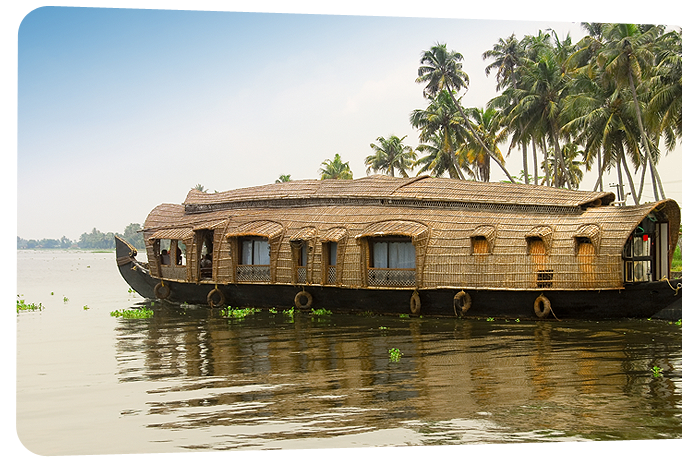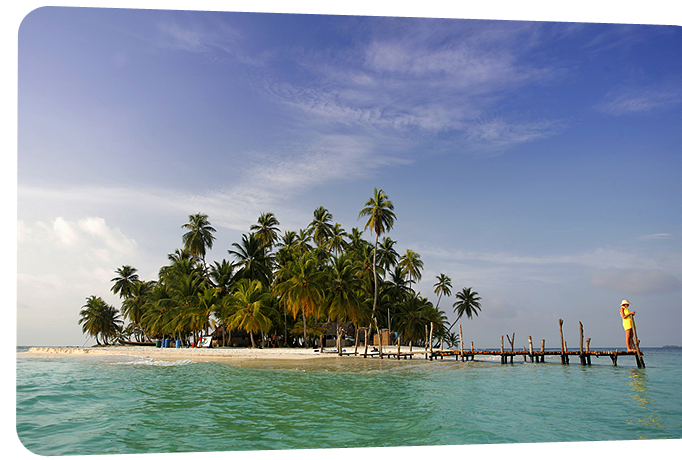EXPLORE RAJASTAN
DELHI-AGRA-BHARATPUR- JAIPUR-BIKANER-JAISALMER- JODHPUR-UDAIPUR-PUSHKAR-DELHI
14 Nights/15 Days
| Day 01 |
Arrive Delhi : Flight No LX 146 |
Arrives Delhi : 0045 Hrs |
 On arrival in Delhi: Company representatives cannot come into the baggage collection area. Having cleared immigration, collected your luggage and passed through customs, please make your way towards the exit of the terminal building where you will see a bank of people waiting for you. Amongst them will be our Representative who will be waiting to greet you with a paging board with your name on. Please note that the crowds can be enormous and it is possible that you may not spot our representative, despite their making every effort to be as visible as possible, so please keep an eye out for them. On arrival in Delhi: Company representatives cannot come into the baggage collection area. Having cleared immigration, collected your luggage and passed through customs, please make your way towards the exit of the terminal building where you will see a bank of people waiting for you. Amongst them will be our Representative who will be waiting to greet you with a paging board with your name on. Please note that the crowds can be enormous and it is possible that you may not spot our representative, despite their making every effort to be as visible as possible, so please keep an eye out for them.
You are then transferred to your hotel and assisted with check in.
(Room booked for immediate occupancy)
India’s capital and a major gateway to the country, contemporary Delhi is a bustling metropolis, which successfully combines in its folds - the ancient with the modern. Amidst the fast spiraling skyscrapers the remnants of a bygone time in the form of its many monuments stand as silent reminders to the region’s ancient legacy. The first impressions for any visitor traveling in from the airport are of a specious, garden city, tree-lined with a number of beautiful parks.
Afternoon proceed for tour of New Delhi, which reflects the legacy the British left behind. The division between New and Old Delhi is the division between the capitals of the British and the Mughals respectively. The division in the walled city and New Delhi also marks the division in the life-styles. The walled city is all tradition where one will be able to glean a past life-style in all its facets, colours and spells. New Delhi in contrast, is a city trying to live up to the best of 21st century standards.
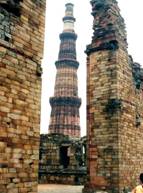 The tour to Imperial Delhi will include a visit to the Qutab Minar, the tallest stone tower in India. The Qutab Minar was started in 1199 AD by Qutab-ud-Din Aibak and completed by the sultan's successor and son-in-law, Iltutmish. The building is 72.5 m high and has 379 steps from the bottom to the top. The Minar is tapering with the diameter of the base is 14.3 m while at the top floor it is2.7 m. The Qutab Minar is still the highest stone tower as well as one of the finest Islamic structures ever raised in India. The tour to Imperial Delhi will include a visit to the Qutab Minar, the tallest stone tower in India. The Qutab Minar was started in 1199 AD by Qutab-ud-Din Aibak and completed by the sultan's successor and son-in-law, Iltutmish. The building is 72.5 m high and has 379 steps from the bottom to the top. The Minar is tapering with the diameter of the base is 14.3 m while at the top floor it is2.7 m. The Qutab Minar is still the highest stone tower as well as one of the finest Islamic structures ever raised in India.
Then visit Humayun’s Tomb, built by the widow of the second Mughal Emperor, Humayun, it is an outstanding monument in the Indo-Persian style, a precursor of the Taj Mahal. The tour also includes a drive past the imposing India Gate, the Parliament building and the Rashtrapati Bhawan, the President’s residence.
Overnight will be at the hotel
Breakfast at the hotel
After breakfast, you will be taken for a half day sightseeing tour of Delhi.
Begin with Old Delhi, the Mughal Capital of Shahjahanabad. Visit the Jama Masjid - The mosque of Friday was built from 1644 to 1658 during the reign of Shahjahan. The mosque which measures 65m on 35m, and whose court forms a square of 100m on
side is by its surface the greatest religious construction of Islam; Raj Ghat where Mahatma Gandhi – The Father Of Nation, was cremated and the Red Fort[ from outside] - the palace for Shahjahan new capital, Shahjahanabad, the seventh Muslim city in the Delhi site. Wander in the busy streets of the mile long Chandni Chowk, popularly called “The Silver Street”.
Afternoon at leisure.
Overnight will be at the hotel
Breakfast at hotel
After breakfast you will drive to Agra [Approx 205 Kms / 5 hrs]
On arrival check into hotel.
Afternoon proceed for the half day tour of Agra
Begin you tour with Agra Fort, an outstanding example of Mughal architecture. Agra Fort - the seat and the stronghold of the Mughal Empire under successive generations. This was the seat of Mughal rule and administration and the present structure owes its origins to Akbar who erected the walls and gates and the first buildings on the eastern banks of Yamuna River. Shah Jehan added the impressive quarters and the mosque while Aurangzeb added the outer ramparts. Visit its Hall of Public Audience and its Royal Pavilions. Also visit Itmad-Ud-Daulah, famously called Baby Taj.
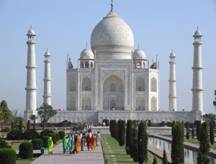 In the evening, you will be taken for a sunset visit to Taj Mahal (Closed on Friday). Taj Mahal is everything that has been said about it and more. Taking 22 years and 20,000 men to build, the white marble was quarried 200 miles away and was transported to the site by a fleet of 1000 elephants. Built by the Mughal Emperor Shah Jahan as an expression of his love for his wife Mumtaz Mahal, in mid 17th century, it is truly one of the wonders. Though the Taj appears to be amazingly perfect from almost any angle, it is the close-up marble inlay work, which is really astounding. You will have ample time to view and be mesmerized by this outstanding piece of architecture. In the evening, you will be taken for a sunset visit to Taj Mahal (Closed on Friday). Taj Mahal is everything that has been said about it and more. Taking 22 years and 20,000 men to build, the white marble was quarried 200 miles away and was transported to the site by a fleet of 1000 elephants. Built by the Mughal Emperor Shah Jahan as an expression of his love for his wife Mumtaz Mahal, in mid 17th century, it is truly one of the wonders. Though the Taj appears to be amazingly perfect from almost any angle, it is the close-up marble inlay work, which is really astounding. You will have ample time to view and be mesmerized by this outstanding piece of architecture.
Overnight will be at the hotel
Breakfast at the hotel
After breakfast you will drive to Bharatpur [Approx 56 Kms / 01 Hr]
 Enroute visit Fatehpur Sikri. Built during the second half of the 16th century by Mughal emperor Akbar, Fatehpur Sikri (the city of victory) was capital of the Mughal Empire from around 10 years. The complex of monuments and temples, all in a uniform architectural style, includes one of the largest mosque in India – Jama Masjid. Enroute visit Fatehpur Sikri. Built during the second half of the 16th century by Mughal emperor Akbar, Fatehpur Sikri (the city of victory) was capital of the Mughal Empire from around 10 years. The complex of monuments and temples, all in a uniform architectural style, includes one of the largest mosque in India – Jama Masjid.
Bharatpur is the eastern gateway to Rajasthan.
Bharatpur is popular for its bird sanctuary near the Keoladeo Ghana National Park, which is the finest in Asia with a rich avian variety. Every year, the rare Siberian cranes come to spend the winter in the warmer climate of Bharatpur.
On arrival you will check in at your hotel
Afternoon proceed for the park visit
Keoladeo Ghana Bird Sanctuary occupies an area of 29 sq km. The park was initially created by the Maharaja of Bharatpur in the 19th century as he desired to save his town from the calamitous flood water. The dam he built left back a depression which was later converted into Bharatpur Lake. The lake served as a hunting preserve for the Maharaja for quiet sometime before it was finally declared a National Park in the year 1982. It gained the status of the World Heritage Site in the year 1985. The 29 sq km of the park is majorly covered with kadam forests, grasslands and shallow lakes. Birds are the prime attraction for the visitors in this park. Around 350 species of birds, both resident and migratory, can be seen in this park. The most popular and awaited guest of the park is the highly endangered Siberian Cranes. The bird is known to fly to just two destinations in winters, viz., Iran and Bharatpur. Other birds that form a major attraction in the park include Pelicans, Geese, Ducks, Ibises, Egrets, Eagles, Hawks, Warblers, Wheatears, Flycatchers, Buntings, Larks, Shanks, Stints, Wagtails and Pipits. You will explore the Park enjoying rickshaw ride at a comfortable pace without disturbing the inmates. The rickshaw pullers are all trained by the forest officials and hence know the area pretty well. Guided by them, it is easier to spot more number of birds.
Overnight will be at the hotel
| Day 05 |
Bharatpur - Jaipur |
|
Breakfast is at hotel
After breakfast you will drive to Jaipur [183 Kms / 04 Hrs]
On arrival check in at your hotel
Jaipur, also known as the Pink City of India, was founded by Maharaja Jai Singh II (1693-1743) and is the capital of Rajasthan. Jaipur is surrounded by hills and dotted with forts, and is one of the links to the famed Golden Triangle of North India along with Delhi and Agra. Jaipur also serves, as the most convenient entry point to Rajasthan, India's most colorful and vibrant state. An extremely well planned city, it was designed by an engineer and scholar Vidyadhar Bhattacharya, in accordance with ancient Hindu treatise on architecture, the Shilpa Shasta (Vastu). It was planned in a grid system with wide straight avenues, roads, streets and lanes and uniform rows of shops on either side of the main roads. Jaipur remains the only place where the nine sectors that sub-divide the city symbolize the nine divisions of the universe. Jaipur is surrounded by a wall having seven gates and was built for protection from invading armies and wild animals that lurked just outside in the jungles that surrounded the city.
Overnight will be at the hotel
Breakfast is at the hotel
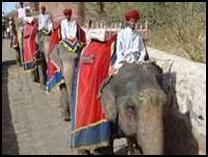 After breakfast, you will be drive just outside Jaipur to After breakfast, you will be drive just outside Jaipur to
the ancient capital of Amber to see the fabulous Amber Fort. Maharaja Mansingh, Mughal Emperor Akbar’s most successful General, started the construction of Amber Fort in the 17th century. Before the City Palace was constructed in Jaipur, Amber was the seat of power. The fort is surrounded by fortified battlements and overlooks the Moat Lake. Ruins and remains are spread over the Aravalli hills and sprawling crenulated walls lattice the surrounding area.
An elephant [Subject to availability/alternatively by jeep] will spare you the trouble of reaching up to the fortress. Once on top, stroll through the sprawling complex of courtyards and halls; Many of the rooms have delightful wall paintings, with precious stones and mirrors inlaid in the walls. Most fascinating, perhaps, is the Sheesh Mahal (hall of mirrors) where a single lamplight is reflected in the many mirrors, lighting up the room. En-route to Amber you will stop and see the `Palace of Winds’, otherwise known as Hawa Mahal. It is really an elaborate facade behind which the ladies of the court used to watch the daily goings on in the street below. It is extremely intricate in its pink sandstone carving. The cool wind blows through its facade of windows and latticed screens through which the queens of the court once viewed the streets of the city.
In the afternoon, you will be taken for a half day sightseeing tour of Jaipur city.
Among the highlights to be seen while touring Jaipur include the City Palace, which is an overwhelming complex of exquisite palaces, gardens and courtyards, decorative art and carved doorways. The palace museum houses collections of rare manuscripts, armory, costumes, carpets and miniature paintings. Walk to the adjacent Jantar Mantar or Astronomical Observatory made by the Maharaja of Jaipur, built in 1726 and is one of the five such astronomical wonders built by Sawai Jai Singh and makes accurate predictions even to this day. You will also have the opportunity to wander about the local markets
Overnight will be at the hotel
Breakfast is at the hotel
After breakfast depart for Bikaner [Approx 320 Kms / 7 Hrs]
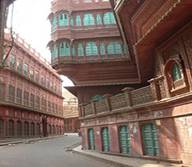
Lying in the north of the desert state, the city is dotted with scores of sand dunes. Bikaner retains the medieval grandeur that permeates the city's lifestyle. More readily called the camel country; the city is distinguished for the best riding camels in the world and hence boasts of having one of the largest Camel researches and breading farm in the world. The ship of the desert is an inseparable part of life here. A camel besides doing transportation duties, also works on wells. These are built on high plinths with slender minarets on each of the four corners and can be noticed even from a distance
On arrival you will check in at your hotel
Afternoon you will proceed for the sightseeing tour of Bikaner visiting Junagarh Fort, one of the most interesting forts in Rajasthan, with its sumptuously decorated interiors. Built in 1588 by Raja Rai Singh it is unusual in the sense that it was one of the few major forts of Rajasthan that was not built on a hilltop. Instead, it was built on the desert plains; its rugged sandstone bastions and graceful pavilions and balconies are silhouetted against the sky.
Overnight will be at the hotel
| Day 08 |
JBikaner-Jaisalmer |
|
Breakfast is at the hotel
After breakfast you will depart for Jaisalmer [Approx 330 Kms / 07 Hrs]
Jaisalmer, the golden beauty etched in yellow sandstone, standing tall against miles of gleaming sand. Founded in 1156 AD by Maharawal Jaisal, Jaisalmer’s location kept it almost untouched by outside influences and even during the days of the Raj, Jaisalmer was the last to sign the Instrument of Agreement with the British. Very few cities can boast of the magnificence that surrounds Jaisalmer. There is a fort that seems to rise out of a desert haze, its yellow sandstone walls and bastions taking on a golden hue in the afternoon sun, which is why it is aptly called Sonar Kila or the Golden Fort.
Overnight will be at the hotel
Breakfast is at the hotel.
This morning take a half-day sightseeing tour of this city of gilded magic; See the fort built by Rawal Jaisal atop the 80 m high Trikuta hill, where a fourth of the population still lives. Within the fort are also beautifully carved Jain temples of the 12th to the 15th centuries. See Badal Vilas Palace - the former ruler’s 20th century palace; Also visit some impressive merchant mansions (havelis) including Patwon ki Haveli (1805), a five-storey building with carved pillars and murals, Salim Singh and Nathmalji ki Haveli.
Evening enjoy the camel ride on sand dunes of Sam.

As the Royalty traversed stretches of desert on camels, the evenings see you astride colorfully caparisoned camels led by ethnically dressed butlers as you begin your sojourn of miles of shimmering sand dunes into the sunset. Lounging on the dunes, one can only gaze in breathless wonderment as the sun begins to go down and casts an ember halo over the desert horizon.
Overnight will be at the hotel
Breakfast is at the hotel
After breakfast you will depart for Jodhpur [Approx 266 Kms / 06 Hrs]
Jodhpur- the second largest city in Rajasthan lies at the entrance to the Thar Desert in a region called Marwar. The old city, founded in 1459, is surrounded by a 10 km long wall. The massive Meherangarh Fort overlooks the city and the red sandstone palaces within the fort form one of the most impressive complexes in Rajasthan. Jodhpur is also called ‘blue city’ because of the indigo-washed houses in the old town.
On arrival you will check in at your hotel
Afternoon proceed for the half day tour of Jodhpur
Here, you will be taken for a half day sightseeing tour of the city. Sightseeing will include a visit to the Meherangarh Fort, situated on a low sandstone hill. The 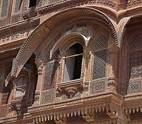 palace apartments like Sukh Mahal, Phool Mahal, and Sheesh Mahal etc. are beautifully decorated and house jewellery, costumes, armor, palanquins, howdahs and other remnants of the past. Also visit the Jaswant Thada, an imposing marble memorial to Maharaja Jaswant Singh II built in 1899.Later the royal crematorium and three other cenotaphs were also built here palace apartments like Sukh Mahal, Phool Mahal, and Sheesh Mahal etc. are beautifully decorated and house jewellery, costumes, armor, palanquins, howdahs and other remnants of the past. Also visit the Jaswant Thada, an imposing marble memorial to Maharaja Jaswant Singh II built in 1899.Later the royal crematorium and three other cenotaphs were also built here
Overnight will be at the hotel
Breakfast is at the hotel
After breakfast depart for Udaipur [Approx 266 Kms / 06 Hrs]
Enroute visiting Ranakpur
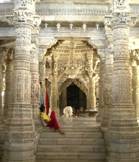 Ranakpur Jain Temple. Ranakpur is the largest Jain temple complex in India and dates to the 15th century. The main temple is dedicated to Adinath, the first Tirthankar. Ranakpur Jain Temple. Ranakpur is the largest Jain temple complex in India and dates to the 15th century. The main temple is dedicated to Adinath, the first Tirthankar.
Intricate carvings detail mythological figures, patterns and motifs on the walls, pillars and domes. There are 1444 ornately carved marble pillars in the complex and none of them are similar. The beautiful lace-like interiors of the domes are a superb example of western Indian temple style. Surya temple and other Jain temples are side attractions.
Note: Temples open only at 1100 Hrs. Leather belts, footwear, bare legs and black clothing not allowed).On arrival, check-in at hotel.
Later continue your drive to Udaipur
Set amidst the Aravalli hills of south Rajasthan, Udaipur (City of Sunrise) is a beautiful city regarded as one of the most romantic in India. Presenting an enchanting image of marble palaces, placid lakes, attractive gardens and green hills, it has been called “the Venice of the East”. It was founded by Maharana Udai Singh II in 1568 as a traditionally planned, fortified city full of palaces, temples and Havelis. The city also became a center for the performing arts, painting and crafts.
On arrival you will check in at your hotel.
Overnight will be at the hotel
Breakfast at the hotel
After breakfast proceed for sightseeing tour.
After breakfast you will be taken for a half day sightseeing tour of Udaipur visiting city Palace. Built in 1725, the grand City Palace is actually a conglomerate of eleven palaces overlooking the sprawling Lake Pichola. Then proceed to Jagdish Temple. Built in 1651 by Maharaja Jagat Singh, this temple is dedicated to Lord Vishnu and is located in the centre of the old city. The temple has a black marble image of Lord Vishnu, which is unusual for the northern part of the country, where statues of Gods are normally in marble. Also visit Sahelion-ki- Bari.
In the evening, you will enjoy a common boat cruise on Lake Pichola.
Overnight will be at the hotel
Breakfast is at the hotel
After breakfast you will drive to Pushkar [285 Kms / 7 Hrs]
Pushkar means born due to a flower. In Hindu mythology it is said that the gods released a swan with a lotus in its beak and let it fall on earth where Brahma would perform a grand yagna. The place where the lotus fell was called Pushkar;
Later in evening proceed for sightseeing tour of Pushkar visiting:-
 Pushkar is among the five dhams or pilgrimages that are held in high esteem by Hindus, the others being Badrinath, Puri, Rameswaram, and Dwarka. It is said that in battle lord Brahma killed the demon Vajra Nabh with a lotus flower, whose petals floated down to earth and landed in three places in and around Pushkar where lakes sprang up. According to legends, Pushkar Lake was surrounded by 500 temples and 52 palaces (several rajas and maharajas maintained palaces here for pilgrimage) at one point. The Brahma temple is the most important temple here and is, in fact, the only Brahma temple of India. Pushkar is among the five dhams or pilgrimages that are held in high esteem by Hindus, the others being Badrinath, Puri, Rameswaram, and Dwarka. It is said that in battle lord Brahma killed the demon Vajra Nabh with a lotus flower, whose petals floated down to earth and landed in three places in and around Pushkar where lakes sprang up. According to legends, Pushkar Lake was surrounded by 500 temples and 52 palaces (several rajas and maharajas maintained palaces here for pilgrimage) at one point. The Brahma temple is the most important temple here and is, in fact, the only Brahma temple of India.
Overnight will be at the hotel
| Day 14 |
Pushkar - Ajmer- Delhi |
|
Breakfast at the hotel
After breakfast you will drive to Delhi from Pushkar
Full day drive since it’s a long drive
On arrival check in at the hotel
Overnight will be at the hotel.
Breakfast is at the hotel
After breakfast you will be met and transferred to the airport to board your flight to Zurich
Tour Ends |

